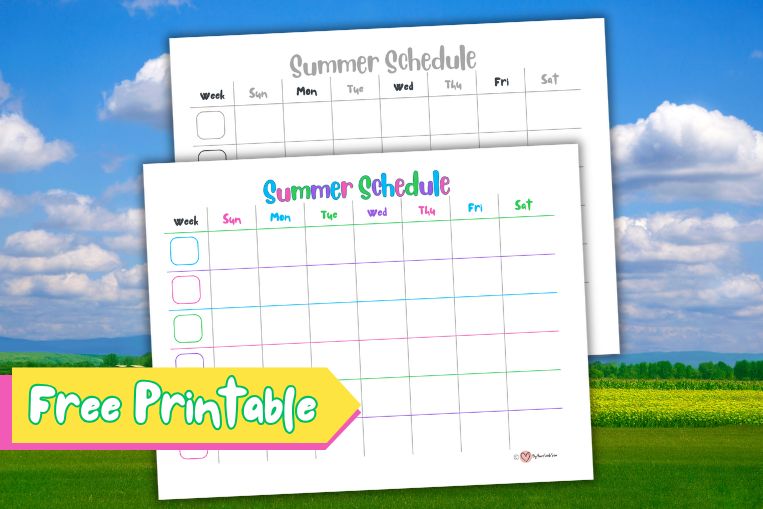
Tips For A Daily Summer Schedule For Kids (Plus Free Printable Schedule)
This post may contain affiliate links. Disclosure Policy
Luci McQuitty HindmarshThe summer school break is a mixed blessing for parents. On the one hand, you get to spend more time with your kids… On the other hand, you spend more time with your kids!!! This is where a summer schedule comes in.
Whether you’re working full-time and need to find activities for your kids during the day, or you just want to make sure they’re not spending all their time in front of a screen, a summer schedule can be a lifesaver.
A simple summer schedule gives structure to the long hot days of summer, meaning your kids get to make the most of their school break and create happy memories.
Plus, almost more importantly, you get to keep your sanity intact!
So, let me walk you through how to put together a simple schedule that will take you smoothly through the summer.
A plan that ensures your kids are engaged and active while also giving you some much-needed time to get stuff done and even some time for yourself.
Example summer day schedule for kids
Here is an example of a full-day summer schedule.
It’s a moveable feast, clearly some days out will take up most of the day, but think of this as your basic plan and then adjust it as needed:
|
Time
|
Activity
|
|---|---|
|
7:30 am
|
Morning routine and breakfast
|
|
9:00 am
|
Reading and quiet time (parents: work admin/chores)
|
|
10:00 am
|
Playtime - garden or park
|
|
12:00 pm
|
Lunch - prep, eat, clear-up
|
|
1:00 pm
|
Positive screentime: TV/devices (parents: headspace)
|
|
2:00 pm
|
Crafts/activities/family outing
|
|
6:00 pm
|
Dinner - prep, eat, clear-up
|
|
7:00 pm
|
Wind-down activities
|
|
7:30pm
|
Bedtime routine
|
Things to consider when planning your schedule
Balancing fun and learning loss
Learning loss is one of the main challenges that parents face during the long summer school break.
Learning loss is the loss of knowledge and skills that kids experience when they are away from school for extended periods.
It can have long-term effects on kids’ academic achievements. This is particularly pertinent in a post-lockdown world.
The best way to guard against learning loss is to build learning opportunities into the summer. This can be as simple as ensuring that kids read on a daily basis.
Ok, this isn’t always that simple, but even ten minutes of reading an actual book or having a book read to them is better than nothing.
Summer Learning Opportunities
Here are some tips for building learning opportunities into your kids’ summer schedule:
- Include daily reading time to keep your kids’ progressing – read to or with them if they struggle.
- Choose a theme for the week or month and plan activities and crafts around it to keep things interesting.
- Incorporate healthy habits like exercise and outdoor play into your schedule to promote physical and mental well-being.
- Create a summer bucket list of interesting and fun things to do that also have educational value. Visiting museums, galleries, historical buildings and places, and trips to the theatre are all good.
- Make screentime positive. Look for apps and games that have educational value.
- Balance screen time with screen-free activities like art projects, board games, and outdoor adventures.
Now we’ve got the bones of a schedule plotted out, let’s do a quick run-through of things to consider when putting a schedule together.
How To Get The Right Activity Mix In The Schedule
These are the things that will help you ensure that you have a schedule that works for everyone.
Morning Routine
Establishing a morning routine can help your kids start the day off right. Consider creating or buying a chore chart or giving your kids a list of tasks to complete each morning. This could include making their bed, brushing their teeth, and getting dressed.
It could also include being in charge of making breakfast for older kids.
Behaviour
Make sure to set clear expectations for your kids’ behaviour. You can do this by creating a behaviour chart or establishing consequences for misbehaviour up front if you have kids who like to push boundaries. This will help your kids understand what is expected of them and promote positive behaviour.
Crafts
Get creative with your kids by making crafts together. You can find plenty of ideas online, or you can come up with your own. Try making paper mache animals, painting rocks, or creating a scrapbook of your summer adventures. Red Ted Art has tonnes of simple but brilliant craft ideas for kids.
Independent play
Encourage your kids to play independently by setting up a designated play area. This could be their bedroom or in one of the living spaces in your home. But gather together all the toys they are currently interested in and make it an enticing space for them to play independently.
Outdoor fun
Make the most of the summer weather by providing your kids with outdoor toys or activities. Trampolines are endlessly popular, though you do need to be very clear on safety rules. In my experience, sidewalk chalk can provide endless fun. Balls, skipping ropes, hula hoops.
Mud kitchens are always lots of fun and don’t need to involve you in buying anything special. You can create one using old kitchen utensils.
Water play is always a big hit on hot summer days. This can be as simple as playing under a sprinkler,
Active play
It is really important to make sure that kids get enough exercise during the summer break. Whilst some kids have trouble sitting still, others are quite happy to loll around unless you get them motivated.
Encourage your kids to stay active by playing games and doing activities that get them moving. Regular trips to the local park in the morning, either to the playground or to ride their bikes or rollerskate.
Clubs and teaming up with other parents
Don’t feel like you have to do it all by yourself. There are an increasing amount of summer clubs for kids to take part in, and they don’t have to cost a lot of money.
I can highly recommend PGL holidays (for kids aged 8+) if you really want to build in some quality summer camp time for your kids that also gives you a solid stretch of time to work.
My daughter went for the first time last year, and we’ve already booked again for this summer. She went with a friend, and they were both slightly nervous before they got there but spent the car journey home begging to go again the following year. So they will be heading off to PGL again this summer for five days.
Summer bucket list
Create a summer bucket list with your kids before the start of the summer break. Fill it with fun and interesting things that everyone would like to do.
This could include things like regular family games nights and visits to the local playground to day trips to theme parks, sightseeing new places and more ambitious trips.
Screen time
Most of us parents are keen to balance the amount of time our kids spend looking at screens.
Experts recommend that children aged 5-18 should have no more than two hours of screen time each day. This includes time spent on smartphones, tablets, computers, and watching TV.
So setting boundaries around screen time is essential – both for kids and also for us parents, to make sure we are modelling good tech behaviour.
Consider setting specific times of the day when screens are allowed and then be very clear about when they are not.
I would say, however, that it is important to distinguish between mindless scrolling and using devices for positive screen time.
Encouraging kids to use their screen time for educational purposes, such as learning to code or playing educational games, is a great way of letting them lose on their devices whilst also ensuring they don’t suffer learning loss.
Allow kids the chance to get bored
It can feel like there is a lot of pressure to fill your child’s entire summer schedule with activities and things to do.
However, it is useful to remember the value of allowing kids the chance to get bored.
While it may seem counterintuitive, boredom can actually be a positive thing for kids.
When children are bored, they are forced to use their imaginations and creativity to come up with ways to entertain themselves.
This can lead to a greater sense of independence and self-reliance, as well as improved problem-solving skills.
Boredom can also help children develop a greater appreciation for the simple things in life, such as spending time outdoors, reading a book, or the fun that can be had through imaginative play.
By allowing your child the chance to get bored, you are helping them develop important life skills while also giving them the space and freedom to explore their own interests and passions.
Don’t want to totally let them freewheel? Here’s a quick guide to setting up a boredom jar full of ideas to curb the “I’m bored” holla!
Sleep
I’m going to end with a quick thought on sleep. In my experience, it can be very easy to let bedtime slide later and later during the summer break.
Whilst it is lovely not to have to stick to rigid timings, it is actually a good idea to try and roughly stick to the same bedtime for kids each evening.
Getting enough sleep is crucial for kids’ physical and mental health, especially during the summer when they may be more active than usual.
So, I thought I’d include a table that shows the recommended hours of sleep per night for children between 5 and 11 years old.
Clearly, every child is different and may need more or less sleep than the recommended hours.
However, the table above provides a general guideline to help ensure your child is getting enough sleep.
| Child’s Age | Hours of Sleep per Night |
|---|---|
| 5 years old | 10-11 hours |
| 6 years old | 10-11 hours |
| 7 years old | 9-11 hours |
| 8 years old | 9-11 hours |
| 9 years old | 9-11 hours |
| 10 years old | 9-11 hours |
| 11 years old | 9-11 hours |
Your Free Printable Summer Schedule

Ready to put all of this juicy intel into action? Download our free printable summer schedule for kids.
Simply pop your email address in the form below and the schedule will be winging its way to your email inbox.
Before you go, you might also like...
- 50 Free Outdoor Activities for Kids: No-Cost Summer Fun (+ Printable Schedule)
- Energy Burners That Get Kids Moving (And Off Their Screens!)
- 10-Minute Wonders: Screen-Free Activities While You Finish That Work Call
- 30 Fun Summer Activities And Projects Kids Can Do By Themselves
- 13 Fun Family Indoor Activities to Enjoy at Home on Cooler Days
- Screen-Free Indoor Activities That Bust Rainy Day Boredom

Luci Hindmarsh
Learn MoreI founded Big Heart Little Star after receiving ongoing love for the party and seasonal activities printables I share on my website Mums Make Lists.
I hope you love the printables I create as much as I love designing them.


